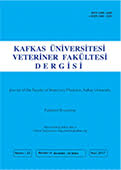
This journal is licensed under a Creative Commons Attribution-NonCommercial 4.0 International License
Kafkas Üniversitesi Veteriner Fakültesi Dergisi
2017 , Vol 23 , Issue 6
The Effect of Ticagrelor on Ischemia-Reperfusion Injury of Kidney: Is the Pleiotropic Effect a Valid Factor?
1Kafkas University, Faculty of Medicine, Urology Department, TR-36000 Kars - TURKEY2Kafkas University, Faculty of Medicine, Pathology Department, TR-36000 Kars - TURKEY DOI : 10.9775/kvfd.2017.17988 The goal of this study was to determine the protective effect of ticagrelor against ischemia-reperfusion injury in the kidney of rats via histological examination, biochemical parameters, and immunohistochemical analysis. Thirty male rats were randomized into five groups. The animals received ticagrelor 5 mg/kg, 10 mg/kg and 20 mg/kg or normal saline 0.1 mL/kg (control) orally before the procedure. The shame group only had laparatomy. An ischemia-reperfusion injury was done by clamping the renal hilus. There was less malondealdehyde assay (MDA) in ticagrelor groups than the control group, and this decrease was statistically significant (P=0.001 in all ticagrelor received groups). The glutathione peroxidase (GPx) and glutathione reductase (GR) were elevated in ticagrelor groups at all doses. Similar findings were observed in all treatment groups. The 5 mg ticagrelor treated group had no changes in glomerules and tubules relative to the control group via histology. Dilated tubular structures were similar to the sham group-both at 10 and 20 mg ticagrelor. Caspas-3 and NF-KB activity was similar in ticagrelor treated groups to sham group. Our study showed that ticagrelor is an effective agent to protect kidney from renal ischemia-reperfusion injury. Ticagrelor may protect the tissues by reducing the concentration of reactive oxygen species and inducing the antioxidant system-especially with the pleiotropic effect. Keywords : Böbrek, İskemi, Reperfüzyon, Hasar, Ticagrelor










